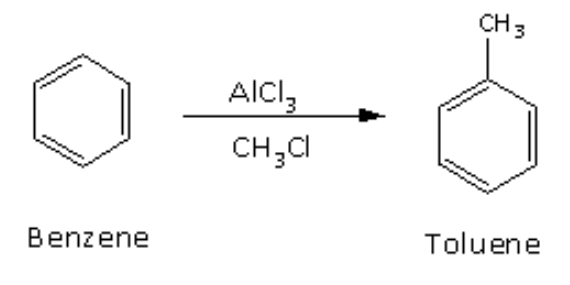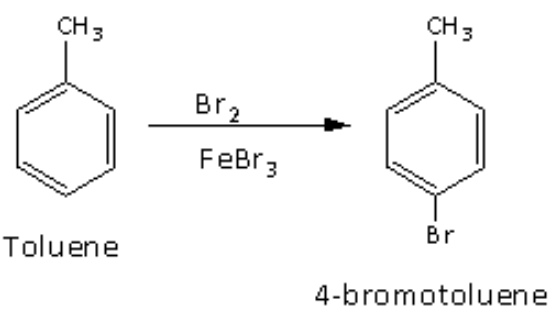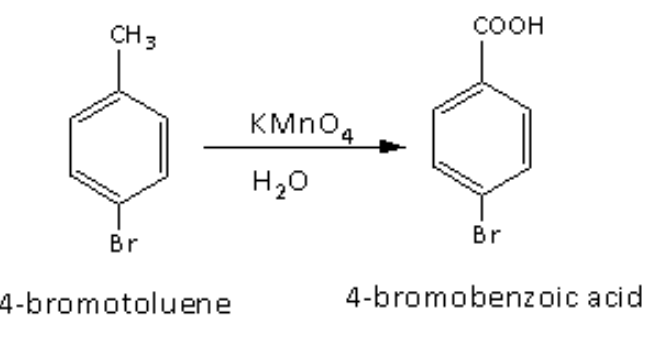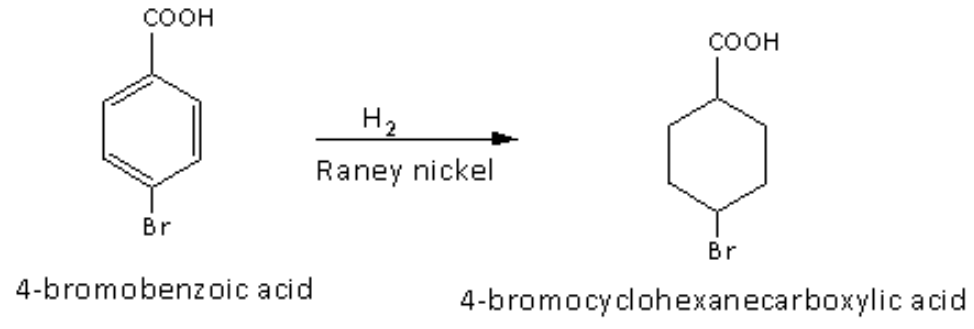
How would you convert benzene into 4-bromo cyclohexanecarboxylic acid?
Answer
449.1k+ views
Hint: Here, the reaction given is the conversion of the benzene to bromocyclopentanecarboxylic acid. This is not the direct conversion, the reaction is taking place with multiple steps.
The conversion of the benzene into 4-bromo cyclohexanecarboxylic acid is carried out s=using the four steps which are as follows:
1) Friedel craft alkylation of toluene.
2) Electrophilic substitution of toluene.
3) Oxidation of 4-bromotoluene to 4-bromo benzene carboxylic acid.
4) Hydrogenation of 4-bromobenzenecarboxylic acid to 4-bromocyclohexanecarboxylic acid.
Complete step by step answer:
Here, first is the conversion of benzene to toluene and it is carried out by the Friedel craft alkylation of the benzene.

Here, aluminum chloride acts as a catalyst which increases the rate of the reaction and facilitates the conversion of benzene to toluene.
Now, toluene undergoes the electrophilic aromatic substitution and gives 4-bromotoluene and the reaction is as follows:

Here, ${\text{FeB}}{{\text{r}}_{\text{3}}}$ is Lewis acid which acts as a catalyst. Thus, toluene on bromination gives 4-bromotoluene.
4-bromotoluene is then converted into 4-bromobenzoic acid. The reaction is as follows:

Here, potassium permanganate carries out the oxidation of the methyl group, and hence, the carboxylic acid is formed.
4-brmobenzoic acid on catalytic hydrogenation gives 4-bromocyclohexanecarboxylic acid.

4-bromobenzoic acid in reaction with Raney nickel gives 4-bromocyclohexanecarboxylic acid. Here, the role of the Raney nickel is hydrogenation that is the addition of the hydrogen across the double bonds of the benzene and form cyclohexane.
In this way, toluene is converted into 4-bromocyclohexanecarboxylic acid.
Note: Friedel craft alkylation is an electrophilic substitution reaction in which the alkyl group is added in presence of the lewis acid aluminum trichloride.
The bromination of the benzene is carried out in presence of the ${\text{FeB}}{{\text{r}}_{\text{3}}}$. Potassium permanganate is an oxidizing agent that can convert the alkyl group to a carboxylic acid. Raney nickel is an important reagent that is used to carry out hydrogenation that is the addition of hydrogen.
The conversion of the benzene into 4-bromo cyclohexanecarboxylic acid is carried out s=using the four steps which are as follows:
1) Friedel craft alkylation of toluene.
2) Electrophilic substitution of toluene.
3) Oxidation of 4-bromotoluene to 4-bromo benzene carboxylic acid.
4) Hydrogenation of 4-bromobenzenecarboxylic acid to 4-bromocyclohexanecarboxylic acid.
Complete step by step answer:
Here, first is the conversion of benzene to toluene and it is carried out by the Friedel craft alkylation of the benzene.

Here, aluminum chloride acts as a catalyst which increases the rate of the reaction and facilitates the conversion of benzene to toluene.
Now, toluene undergoes the electrophilic aromatic substitution and gives 4-bromotoluene and the reaction is as follows:

Here, ${\text{FeB}}{{\text{r}}_{\text{3}}}$ is Lewis acid which acts as a catalyst. Thus, toluene on bromination gives 4-bromotoluene.
4-bromotoluene is then converted into 4-bromobenzoic acid. The reaction is as follows:

Here, potassium permanganate carries out the oxidation of the methyl group, and hence, the carboxylic acid is formed.
4-brmobenzoic acid on catalytic hydrogenation gives 4-bromocyclohexanecarboxylic acid.

4-bromobenzoic acid in reaction with Raney nickel gives 4-bromocyclohexanecarboxylic acid. Here, the role of the Raney nickel is hydrogenation that is the addition of the hydrogen across the double bonds of the benzene and form cyclohexane.
In this way, toluene is converted into 4-bromocyclohexanecarboxylic acid.
Note: Friedel craft alkylation is an electrophilic substitution reaction in which the alkyl group is added in presence of the lewis acid aluminum trichloride.
The bromination of the benzene is carried out in presence of the ${\text{FeB}}{{\text{r}}_{\text{3}}}$. Potassium permanganate is an oxidizing agent that can convert the alkyl group to a carboxylic acid. Raney nickel is an important reagent that is used to carry out hydrogenation that is the addition of hydrogen.
Recently Updated Pages
Master Class 12 Economics: Engaging Questions & Answers for Success

Master Class 12 Maths: Engaging Questions & Answers for Success

Master Class 12 Biology: Engaging Questions & Answers for Success

Master Class 12 Physics: Engaging Questions & Answers for Success

Master Class 12 Business Studies: Engaging Questions & Answers for Success

Master Class 12 English: Engaging Questions & Answers for Success

Trending doubts
What is the Full Form of PVC, PET, HDPE, LDPE, PP and PS ?

What are the major means of transport Explain each class 12 social science CBSE

Draw a neat and well labeled diagram of TS of ovary class 12 biology CBSE

When was the first election held in India a 194748 class 12 sst CBSE

What is pseudocoelom Where is it located class 12 biology CBSE

State the postulates of special theory of relativi class 12 physics CBSE




